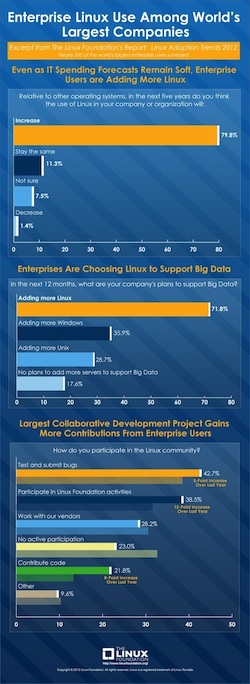These names represent just a handful of the thousands of large companies using Linux today. As early adopters of Linux (some having used the OS well over a decade) with some of the most technically advanced challenges to overcome in their business environments, companies such as these can give us important insight as to how Linux is being used and where it’s growing.
That is why we started surveying large companies using Linux in 2010 and why today’s new report, “Linux Adoption Trends 2012: A Survey of Enterprise End Users,” sheds light on what we can expect from enterprises, both large and small, that are using Linux. We hope this research can help inform the industry, our members and us as we prioritize our work for a New Year.
In order to intimately understand the adoption trends among this elite level of companies, we filtered the responses to our survey to collect just the data from companies with more than $500m+ in annual revenues or 500+ employees. You will find a variety of new data points in this year’s report, but here’s three that I think are interesting and/or surprising.
 Linux is growing, even as spending forecasts remain bleak
Linux is growing, even as spending forecasts remain bleak
Companies using Linux are bucking the forecast trends of reduced spending on IT. Eight out of ten respondents said they’ve added more Linux servers in the last 12 months and will add more in the next 12 months. Eight out of ten are also planning more Linux deployments over the next five years, while only 21.7% said they will be adding more Windows in the next five years.
“Big Data” might be a buzzword, but it’s a real concern
The rising level of data is not lost on large companies. In fact, it’s a concern for more than 75% of our respondents. With the number of collection points spreading and more elements of our personal and professional interactions being digitized, the term “Big Data” is becoming part of our regular vocabulary. We were very interested to learn that more than two-thirds (or 71.8%) are planning to add more Linux in the next 12 months to support it. Given Linux’s incumbent position in high-performance computing (HPC), maybe this shouldn’t come as a surprise.
Overall concerns/issues with Linux dropping
While management perception remains at the top of the list of concerns among even large enterprise users, we found that few people see much impeding Linux’s ongoing success. In fact we saw a 40% drop in people who thought technical issues would hold back the platform. Ten percent fewer this year say there are no issues at all impeding the success of Linux.
The 2012 Enterprise End User survey surfaces a very positive story for Linux among enterprises who use the operating system most. As our report says, “Once enterprises deploy Linux, they stick with Linux and plan to add more Linux, because the platform provides sustainable benefits that include a broad feature set, security, cost-savings and flexibility.”
One last note: This report is not intended to be an assessment of the overall penetration of Linux in the market, or is it a cross-platform study. This “Linux Adoption Trends 2012: A Survey of Enterprise End User” report reflects the usage trends of enterprise users most familiar with Linux, surfacing important data that can inform important work.


